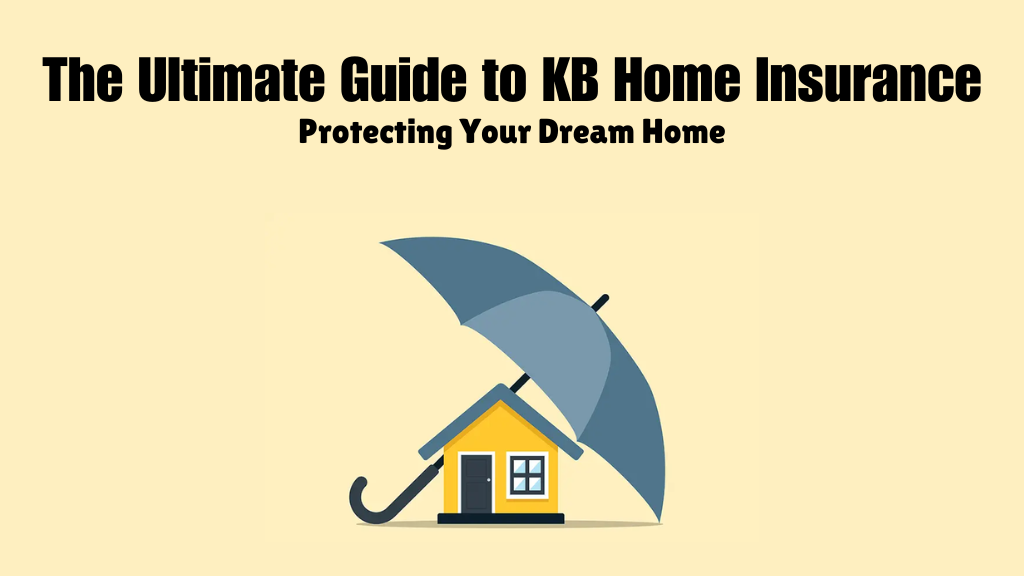The Ultimate Guide to KB Home Insurance Owning a home is a dream for many, and for those who choose KB Home, that dream comes with the peace of mind that comes from knowing their investment is well-protected. KB Home, a renowned home builder, offers not just beautiful homes but also valuable options for home insurance. This comprehensive guide explores everything you need to know about KB Home Insurance, ensuring you can make informed decisions about protecting your new home.
What is KB Home?
KB Home is one of the largest and most established homebuilders in the United States. Founded in 1957, KB Home has built a reputation for quality, energy-efficient homes tailored to the needs and desires of modern families. The company operates in several states, offering a wide range of home styles and designs to suit various tastes and budgets.
Why Home Insurance is Essential
Home insurance is a critical component of homeownership. It provides financial protection against a variety of risks, including:
- Natural Disasters: Hurricanes, earthquakes, floods, and other natural disasters can cause significant damage to your home.
- Theft and Vandalism: Home insurance can cover losses from theft or vandalism.
- Liability Protection: If someone is injured on your property, home insurance can cover medical expenses and legal fees.
- Fire and Water Damage: Accidents happen, and home insurance can help repair or rebuild your home if it is damaged by fire or water.
The Basics of KB Home Insurance
KB Home Insurance is designed to offer comprehensive coverage tailored to the specific needs of KB Homeowners. Here are some key features and benefits:
Customization Options
KB Home Insurance policies are highly customizable. Homeowners can choose from a range of coverage options to suit their specific needs and budget. This flexibility ensures that you only pay for the coverage you need.
Comprehensive Coverage
KB Home Insurance offers comprehensive coverage that includes protection against a wide range of risks. This includes coverage for the structure of your home, personal belongings, liability protection, and additional living expenses if your home is temporarily uninhabitable due to a covered loss.
Competitive Rates
KB Home Insurance is competitively priced, offering excellent value for comprehensive coverage. Homeowners can benefit from discounts and bundling options that can further reduce premiums.
Coverage Options
KB Home Insurance provides various coverage options to meet the diverse needs of homeowners. Here are the primary types of coverage available:
Dwelling Coverage
Dwelling coverage protects the structure of your home, including the walls, roof, and foundation. This coverage helps pay for repairs or rebuilding if your home is damaged by a covered peril, such as fire, windstorms, or vandalism.
Personal Property Coverage
This coverage protects your personal belongings, including furniture, electronics, clothing, and other items. If your belongings are stolen or damaged by a covered event, personal property coverage can help replace them.
Liability Coverage
Liability coverage protects you if someone is injured on your property or if you accidentally cause damage to someone else’s property. This coverage can help pay for medical expenses, legal fees, and other costs associated with a liability claim.
Additional Living Expenses
If your home is uninhabitable due to a covered loss, additional living expenses coverage can help pay for temporary housing, meals, and other expenses while your home is being repaired or rebuilt.
Specialized Coverage Options
In addition to standard coverage, KB Home Insurance offers specialized options to address specific needs:
Flood Insurance
Standard home insurance policies typically do not cover flood damage. KB Home Insurance offers optional flood insurance to protect your home and belongings from flood-related losses.
Earthquake Insurance
Similar to flood insurance, earthquake insurance is not included in standard policies. Homeowners in earthquake-prone areas can opt for this additional coverage to protect their investment.
Extended Replacement Cost
Extended replacement cost coverage ensures that you have enough coverage to rebuild your home, even if construction costs increase. This coverage can be crucial in areas with fluctuating construction costs.
Factors Affecting Home Insurance Rates
Several factors influence the cost of your KB Home Insurance policy. Understanding these factors can help you make informed decisions and potentially lower your premiums:
Location
The location of your home plays a significant role in determining your insurance rates. Homes in areas prone to natural disasters, such as hurricanes or earthquakes, typically have higher premiums.
Home Value and Replacement Cost
The value of your home and the cost to rebuild it are critical factors in determining your insurance rates. Higher-value homes generally have higher premiums.
Deductible Amount
The deductible is the amount you pay out of pocket before your insurance coverage kicks in. Choosing a higher deductible can lower your premiums, but it means you’ll pay more in the event of a claim.
Coverage Limits
The amount of coverage you choose affects your premiums. Higher coverage limits provide more protection but also come with higher costs.
Home Security Features
Homes with security features such as alarms, surveillance cameras, and fire sprinklers may qualify for discounts on their insurance premiums.
Tips for Choosing the Right KB Home Insurance Policy
Selecting the right home insurance policy can be overwhelming, but these tips can help simplify the process:
Assess Your Needs
Consider the value of your home and personal belongings, as well as the potential risks in your area. This assessment will help you determine the amount of coverage you need.
Compare Quotes
Obtain quotes from multiple insurance providers to compare coverage options and rates. This comparison can help you find the best policy for your needs and budget.
Read the Fine Print
Carefully review the terms and conditions of each policy. Pay attention to exclusions, coverage limits, and any additional costs.
Seek Professional Advice
If you’re unsure about which policy to choose, consider consulting with an insurance agent or broker. They can provide expert advice and help you find the best coverage.
The Claims Process
Filing an insurance claim can be a daunting process, but KB Home Insurance aims to make it as straightforward as possible. Here’s a step-by-step guide to filing a claim:
Step 1: Document the Damage
Take photos or videos of the damage to your home and belongings. This documentation will be essential when filing your claim.
Step 2: Contact Your Insurance Provider
Notify your insurance provider as soon as possible. Provide them with the necessary information and documentation to initiate the claims process.
Step 3: Complete the Claim Form
Fill out the claim form provided by your insurance company. Be thorough and accurate in providing details about the damage and the circumstances.
Step 4: Meet with an Adjuster
An insurance adjuster will assess the damage and determine the amount of compensation you are eligible for. Be prepared to answer questions and provide additional information if needed.
Step 5: Receive Compensation
Once the claim is approved, you will receive compensation to cover the repair or replacement costs. The time it takes to receive compensation can vary, so stay in touch with your insurance provider for updates.
Common Myths About Home Insurance
Home insurance can be complex, and there are many misconceptions about what it covers and how it works. Let’s debunk some common myths:
Myth 1: Home Insurance Covers Everything
While home insurance provides extensive coverage, it does not cover everything. Standard policies have exclusions, such as flood and earthquake damage, which require separate coverage.
Myth 2: Home Insurance is Too Expensive
Home insurance is an essential investment in protecting your home and belongings. There are many ways to reduce premiums, such as bundling policies, installing security features, and choosing higher deductibles.
Myth 3: Older Homes Can’t Be Insured
Older homes can be insured, but they may require additional inspections and maintenance. Insurance providers may also recommend upgrades to meet current safety standards.
Myth 4: Home Insurance is Not Necessary if You Have a Mortgage
In fact, most mortgage lenders require homeowners to have insurance as a condition of the loan. Home insurance protects both the homeowner and the lender’s investment.
How to Save on Home Insurance
There are several strategies to reduce your home insurance premiums without compromising on coverage:
Bundle Policies
Many insurance providers offer discounts for bundling home and auto insurance policies. This can lead to significant savings.
Increase Your Deductible
Choosing a higher deductible can lower your premiums. Just be sure you can afford to pay the higher deductible in the event of a claim.
Install Safety Features
Installing safety features such as smoke detectors, security systems, and fire sprinklers can qualify you for discounts on your premiums.
Maintain a Good Credit Score
A good credit score can help you secure lower insurance rates. Pay bills on time and manage debt responsibly to maintain a good credit score.
Review Your Policy Annually
Review your home insurance policy annually to ensure it still meets your needs. Adjust coverage as necessary to avoid paying for unnecessary protection.
KB Home Insurance provides comprehensive and customizable coverage to protect your home and belongings. By understanding your coverage options, assessing your needs, and implementing cost-saving strategies, you can secure the right policy to safeguard your investment. With the right home insurance, you can enjoy peace of mind knowing that your KB Home is well-protected against life’s uncertainties.

